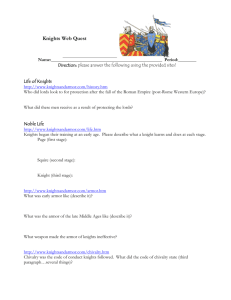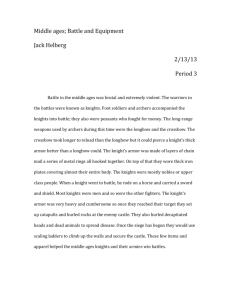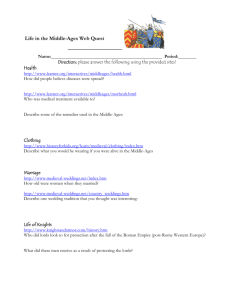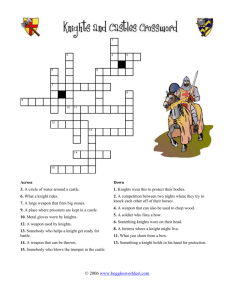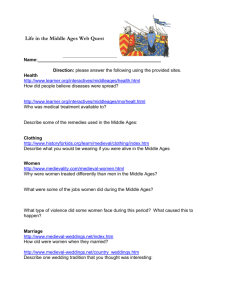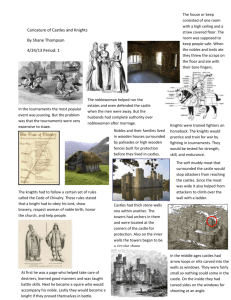Medieval Weapons and Warfare
advertisement
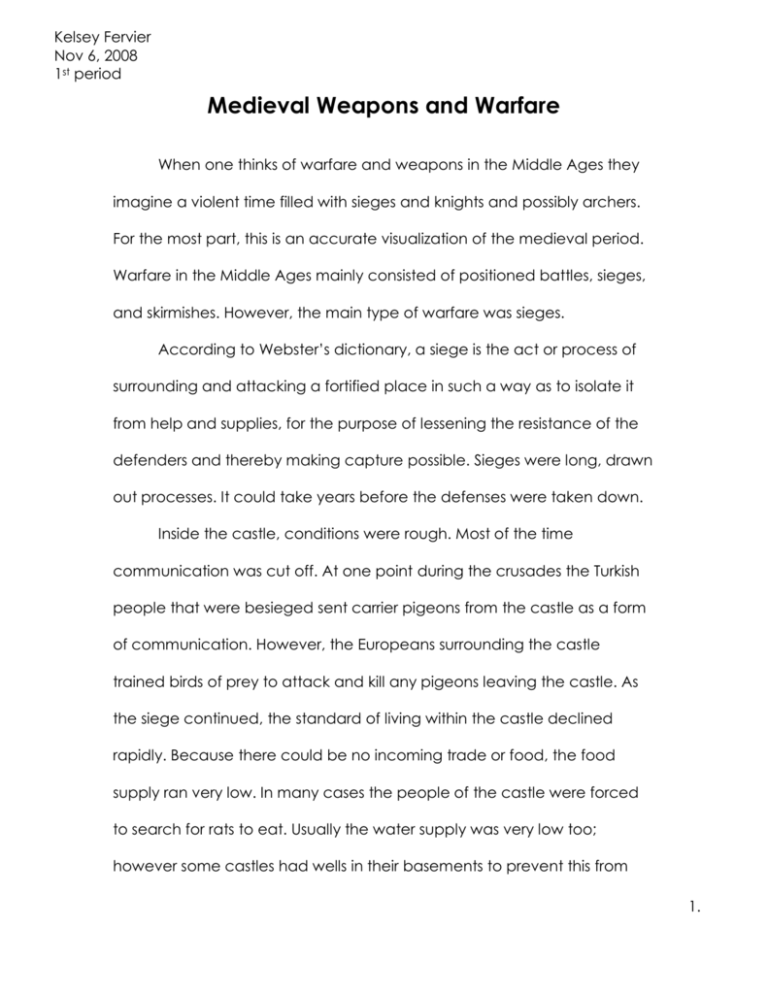
Kelsey Fervier Nov 6, 2008 1st period Medieval Weapons and Warfare When one thinks of warfare and weapons in the Middle Ages they imagine a violent time filled with sieges and knights and possibly archers. For the most part, this is an accurate visualization of the medieval period. Warfare in the Middle Ages mainly consisted of positioned battles, sieges, and skirmishes. However, the main type of warfare was sieges. According to Webster’s dictionary, a siege is the act or process of surrounding and attacking a fortified place in such a way as to isolate it from help and supplies, for the purpose of lessening the resistance of the defenders and thereby making capture possible. Sieges were long, drawn out processes. It could take years before the defenses were taken down. Inside the castle, conditions were rough. Most of the time communication was cut off. At one point during the crusades the Turkish people that were besieged sent carrier pigeons from the castle as a form of communication. However, the Europeans surrounding the castle trained birds of prey to attack and kill any pigeons leaving the castle. As the siege continued, the standard of living within the castle declined rapidly. Because there could be no incoming trade or food, the food supply ran very low. In many cases the people of the castle were forced to search for rats to eat. Usually the water supply was very low too; however some castles had wells in their basements to prevent this from 1. happening. One of the biggest fears was disease and illness because there were so many people in a small enclosed area. There were many different weapons and ideas that were used to try to enter the castle or have the defending castle surrender. At first sieges mainly were just waiting around for the people to starve to death, but as the offenders became more impatient, they began to attack the castle. The three main siege weapons used were catapults, battering rams, and siege towers. A catapult is a military engine used for hurling stones, arrows, and other projectiles. Other weapons in the category of a catapult are trebuchets and ballistas. A trebuchet has a sling in which the projectile is placed and then it has a weighted beam that swings the sling. A ballista is simply a massive crossbow. Catapults at this time could throw things up to 1,000 ft. A battering ram was a siege weapon used to smash castle walls or break down a gate. They consisted of a shed on wheels usually covered in animal pelts or earth to make them fire proof, and a long, thick, tree trunk with a blunt point and an iron tip. This trunk was suspended with metal chains from the top of the shed. To make the wall crumble, soldiers swung the trunk back and forth. Siege towers were large structures used to scale castle walls. They could be up to 100 feet high and they held many people. In the siege of 2. Kenilworth Castle there were 200 archers and 11 catapults in one siege tower! Soldiers would hide in the tower while other soldiers pushed it up against the castle wall. At the top of the siege tower there would be a drawbridge that when lowered allowed the soldiers to enter the castle. Siege towers were very vulnerable because they were entirely composed of wood. This made it extremely easy to burn them down. So many times they were covered in mule or oxen hide. As the siege weapons became more advanced, so did the defenses of the castles being attacked. At first castles were easy to defeat because they were completely made of wood. Destroying a castle with fire was almost too easy. The only things that truly inhibited the attackers were a wall of wooden stakes and a ditch surrounding the entire castle. These castles were called motte and bailey castles. However the castle was set on an artificial mound and usually had a tower, so they could see approaching enemies and alert everyone inside. As time went on castles gradually began to be made out of stone and set on high, natural, rocky hills because the artificial mounds could not support the heavy stone. This made it much easier to prepare for sieges and castle attacks because they could see even farther. If a castle could not be built on a hill or mountain then a river would be diverted to form a moat with water in it. In that moat there would usually be metal or 3. wooden spikes to keep the attackers from mining under the castle. Castles in this time period would have maximum protection. Castles many times had 2 or 3 walls. There were iron gates, or portcullis, that could be lowered over the entrance. If the besiegers managed to break that down there was usually a tunnel followed by another portcullis. In the roof of the tunnel there were holes that allowed things to be thrown from above. There were many aspects of a castle that were specifically designed for the archers benefit. From the outside all of the windows appeared to be small slits, but on the inside the size increased drastically, allowing the archers to have full shooting range. The castle walls also had parapets so that the archers could hide behind them when shooting. Some other defenses included, angled walls that sloped outward, spiral stairs made so that only one soldier or knight could swing a sword, and ledges coming out of the battlements. Battles in the middle ages were horribly chaotic and bloody. The only order was the commanders decided when to send the knights into battle, when to charge, and when the archers were to fire. There were only four rules when in the actual battle: don’t kill your own soldiers, protect the flag at all costs, fighters can only attack members of their own rank, and kill as many of the enemy as possible. Many tactics used in medieval battle dated back all the way back to the Romans and were based on tradition. 4. The three types of warriors in the middle ages were knights, foot soldiers, and archers. A knight in its simplest terms means a soldier who went into battle on horseback. However, as the Middle Ages progressed a knight went on to mean so much more. In the middle ages, knights were the heroes, but they could also be the enemy. Knights saved people, yet they were brutal. Knights were trained killers. Most knights were noblemen because the cost of the finest armor and weapons was too much for the common people. Training to become a knight could start as early as age four. They would start off by learning to ride ponies. At about age 7 they would be given to the Lord of the castle as a page. A page would perform errands and in return be taught how to fight with blunt wooden swords and small, round shields. If a page looked promising he would be promoted to a squire at age 14. A squire’s job was to follow a knight around everywhere he went and assist him. They did a variety of jobs, but his most important one was helping his knight in battle. After a squire had completed his duties he could become a knight. They were “knighted” in a special ceremony by his Lord. The squire had to agree to only use his sword for God. In the beginning of the middle ages knights wore very little armor. The main piece they wore was made of mail. At first knights wore mail shirts, however this progressed into mail pants and long sleeves. By the 14th 5. century knights began wearing the first iron plates attached to a cloth covering. About 100 years later knights were wearing the full suits of armor that we see today. Some examples of this armor were the mitten Gauntlet that protected the hand and wrist, and the Pauldron and Vambrace that protected the entire arm. Knights also used Cuisse and Poleyn for the knee and thigh and a basinet that protected their heads. The most well known and important weapon for a knight was his sword. There were many different swords and most of the time a knight would own several kinds. The two main categories that swords could be put into were, single handed swords and two handed swords. Single handed swords were very light and easy to use. But they could not go through armor easily, which for knights was a problem. They were mainly used by the barbaric tribes and the lower class. Two handed swords were very effective. In fact, they worked so well that one could cut a man with full armor on in half. The main drawbacks were that only a very strong man could use one, and you couldn’t carry a shield. Therefore, knights had to wear very heavy armor when carrying one. Knights also used other weapons such as daggers, lances, maces, Short axes, and ball and chains. The most useful tool a knight had though was his horse. Foot soldiers were used more commonly then knights throughout the Middle Ages. They could be very useful in battle and with the right 6. weapons one could even take down a mounted knight. The most used weapons by foot soldiers were swords, daggers, pikes, spears, and axes. The biggest victory for foot soldiers was in 1302 at the battle of Courtrai. The Flemish pikemen (foot soldiers) killed over 1,000 French knights. In the end of the 14th century foot soldiers began to use guns. Foot soldiers had very simplistic armor compared to knights. Many times they wore just helmets and leather jackets. Occasionally those jackets were riveted with metal plates. Archers were the most feared warriors. A skilled archer could shoot more then six arrows a minute with devastating accuracy. Archers completely changed the way battles were fought. A long bow was capable of going 400 yards; however it was only accurate for the first 200. Children started very young learning how to use a bow and arrow by practicing at targets called butts. The only armor that was specifically required for an archer was a glove on their right hand and a brace on their left wrist. The arrows used were between 30 and 36 inches long with a steel chain mail tip. At the end there were goose feathers for stability. Archers were extremely dangerous in battle and caused massive losses of enemy troops. The main bow used was the long bow, but cross bows were also used. Crossbows could be used by people without very much skill, but they lacked the same type of range a longbow had. Crossbows also took much longer to load. 7. The three most important wars or battles of the Middle Ages were the Crusades, the Battle of Hastings, and the Hundred years war. The crusades were a series of invasions of the holy city of Jerusalem by Christians. The crusades are probably the most well known battles in medieval history. The crusades lasted for almost 200 years, from 1096 until 1270. Throughout this period there were eight crusades and one children’s crusade in 1212. The Europeans, or Christians, felt like Jerusalem belonged to them because it is the city where Jesus spent most of his life. The Christians were also very upset because in 1076 took control of Jerusalem. The Europeans thought it was their calling to go win it back. The Muslims also felt like Jerusalem belonged to them and that it was a sacred place. Their prophet Muhammad was said to have been there and prayed on a rock. The Christians fought to capture it, while the Muslims fought to keep it. The Battle of Hastings took place on October 14, 1066 in Battle, East Sussex. It was fought between the Saxons and the Norman French. William of France felt like the crown of England belonged to him, and not Harold who it was given to. So William invaded England to go retrieve his crown. Harold received word and traveled to Sussex to fight. King William won and from then on England was under French rule. The Hundred years war was a series of raids, naval battles, and sieges between England and France. This was lasted from 1337 until 1453. 8. From the get go the English won many battles including Crecy, Poitiers, and Agincourt. However, in 1429 things took a turn and the French began to gain power. One of the most well known women of all time, Joan of Arc, helped the French defeat the English. Eventually they retreated from France and the 100 years war came to a close. The most important part about warfare in the Middle Ages though was the development of gunpowder. This revolutionized warfare. Towards the end of the medieval period guns and cannons came into use. 9.
